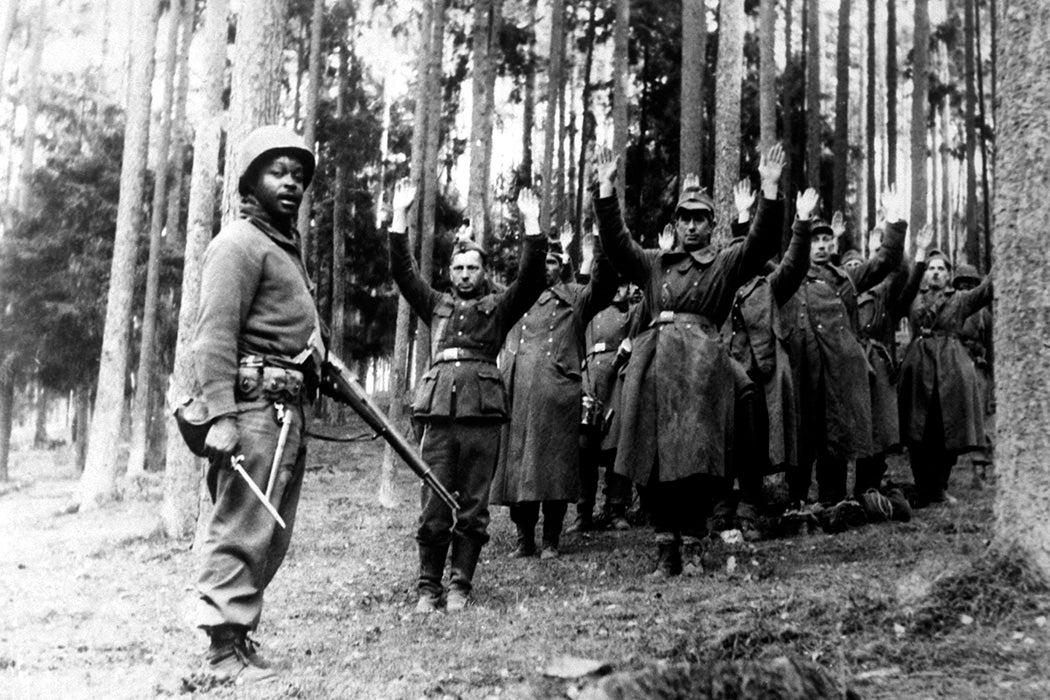There were almost a half million German and Italian prisoners of war interned in the United States during World War II. “The claim that these defeated ‘white’ members of the Axis had more rights and privileges in the United States than black soldiers in American uniforms was a powerful one,” writes scholar Matthias Reiss. Axis prisoners allowed in “whites-only” facilities in the South especially rankled Black soldiers and the larger Black community across the country.
“Although the German prisoners became highly charged symbols of the injustices African Americans had to endure, there was surprisingly little conflict between the two groups,” Reiss notes.
Rather, he explains, forms of solidarity, mutual aid, and sympathy were often forged between POWs and the Black Americans assigned to guard or work alongside them. Second-class visitors and second-class citizens—“prisoners/slaves like us” were descriptions both groups used—united in their underdog status in apartheid America.
Reiss argues that German POWs put to work doing back-breaking “Negro work” like cotton-picking, peanut-harvesting, and pulpwood-logging, “changed their own outlook as well as undermined the racial assumptions that underpinned American society in the 1940s.”
The groups were mostly conflict free, Reiss writes. The German POWs and Black soldiers
worked side by side performing unskilled and unpleasant low-paid labor. Under these specific conditions, German POWS and African Americans developed unusually harmonious relationships, which were remarkably free of conflict. Not only in North America, but also in liberated Europe and occupied Germany, both groups got along very well.
The invasion of North Africa in November of 1942 was the first major American action in the European Theater. Battle meant captured prisoners: more than 371,000 Germans and some 51,000 Italians eventually ended up in the US. By 1945, every state in the Union housed German POWs, with two-thirds of them interned in the South. (Italians were allowed to volunteer in Italian Service Units of the US Army after the Kingdom of Italy switched sides and declared war on Germany in October 1943.)
Black soldiers were at first not allowed to be members of the Military Police (MP) Escort Guards, the soldiers tasked with guarding prisoners of war. The argument was that Black prison guards “would invite enemy reprisals” because international law “banned the humiliation of captured enemy personal.” POWs who worked as waiters in mess halls were likewise not permitted to serve Black soldiers.
The segregated Escort Guard system was disbanded in April 1944, and Black soldiers were allowed to take on guard roles in the US. By then, this had already been happening in North Africa and Europe.
The Geneva Convention allowed for enlisted prisoners being put to work, so the majority of German prisoners were “employed by the US Army on military installations,” with a “substantial number hired out to civilian employers as contract laborers.”
This work program was the result of war’s manpower shortage, but it was also part of a reeducation effort. It was hoped former POWs would become the nucleus of a democratic post-war Germany. The effort included schooling the POWs on the American way of life. But once again, American racism got in the way of its stated democratic and egalitarian ideals—the POWs could see that skin-color determined who got the benefits of American democracy.
Weekly Newsletter
The last German prisoners in the US were repatriated by July 1946. Meanwhile, Black troops in Europe often reveled in the treatment they received there, far from Jim Crow and Lynch Law. That included occupied Germany. Ebony magazine put it succinctly at the time: Black GIs enjoyed “more friendship and equality in Berlin than in Birmingham or on Broadway.” “Liberated Europe” meant something quite unique to them.
The Nazis, like the Soviet Union later during the Cold War, found the US’s white supremacy to be an excellent propaganda weapon. This was sheer hypocrisy, of course, since Nazi race policies were often inspired by American ones. Nonetheless, such totalitarian spotlights shined another light on the fundamental flaw of the American experience—and helped those in struggle against it.







